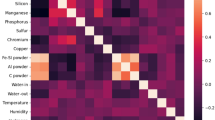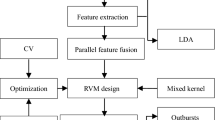Abstract
A model combining kernel principal component analysis (KPCA) and Xtreme Gradient Boosting (XGBoost) was introduced for forecasting the final oxygen content of electroslag remelting. KPCA was employed to reduce the dimensionality of the factors influencing the endpoint oxygen content and to eliminate any existing correlations among these factors. The resulting principal components were then utilized as input variables for the XGBoost prediction model. The KPCA-XGBoost model was trained and proven using data obtained from companies. The model structure was adapted, and hyperparameters were optimized using grid search cross-validation. The model performance of the KPCA-XGBoost model is compared with five machine learning models, including the support vector regression model. The findings demonstrated that the KPCA-XGBoost model exhibited the highest level of prediction accuracy, indicating that the incorporation of KPCA significantly enhanced the regression prediction performance of the model. The accuracy of the KPCA-XGBoost model was 82.4%, 97.1%, and 100% at errors of ± 1.5 × 10−6, ± 2.0 × 10−6, and ± 3 × 10−6 for oxygen content, respectively.








Similar content being viewed by others
References
W. Liu, J. Li, H. Wang, C. Shi, Steel Res. Int. 90 (2019) 1900185.
H. Cao, Z. Jiang, Y. Dong, F. Liu, Z. Hou, K. Yao, J. Yu, ISIJ Int. 60 (2020) 247–257.
Y. Qi, J. Li, C. Shi, ISIJ Int. 58 (2018) 2079–2087.
Y. Chen, S. Wang, J. Xiong, G. Wu, J. Gao, Y. Wu, G. Ma, H.H. Wu, X. Mao, J. Mater. Sci. Technol. 132 (2023) 213–222.
D. Zhu, K. Pan, H.H. Wu, Y. Wu, J. Xiong, X.S. Yang, Y. Ren, H. Yu, S. Wei, T. Lookman, J. Mater. Res. Technol. 26 (2023) 8836–8845.
D.X. Zhu, K.M. Pan, Y. Wu, X.Y. Zhou, X.Y. Li, Y.P. Ren, S.R. Shi, H. Yu, S.Z. Wei, H.H. Wu, X.S. Yang, Rare Met. 42 (2023) 2396–2405.
G. Pan, F. Wang, C. Shang, H. Wu, G. Wu, J. Gao, S. Wang, Z. Gao, X. Zhou, X. Mao, Int. J. Miner. Metall. Mater. 30 (2023) 1003–1024.
L.Z. Che, S.H. Zhang, W.H. Tian, Y. Li, J. Manuf. Process. 101 (2023) 904–915.
S.H. Zhang, L. Deng, Q.Y. Zhang, Q.H. Li, J.X. Hou, Int. J. Mech. Sci. 159 (2019) 373–381.
M. Hugo, B. Dussoubs, A. Jardy, J. Escaffre, H. Poisson, Metall. Mater. Trans. B 47 (2016) 2607–2622.
C.B. Shi, X.C. Chen, H.J. Guo, Z.J. Zhu, H. Ren, Steel Res. Int. 83 (2012) 472–486.
Y. Liu, X. Wang, G. Li, X. Huang, Q. Wang, B. Li, J. Mater. Res. Technol. 9 (2020) 1619–1630.
R.S.E. Schneider, M. Molnar, G. Klösch, C. Schüller, J. Fasching, Steel Res. Int. 91 (2020) 2000241.
Y.X. Liu, Y.W. Dong, Z.H. Jiang, Y.S. Li, W. Zha, Y.X. Du, S.Y. Du, J. Iron Steel Res. Int. 30 (2023) 887–896.
X. Huang, B. Li, Z. Liu, Int. J. Heat Mass Transf. 120 (2018) 458–470.
H. Duan, J. Wei, L. Qi, X. Wang, Y. Liu, M. Yao, Steel Res. Int. 92 (2021) 2100168.
X. Li, R. Jia, R. Zhang, S. Yang, G. Chen, Reliab. Eng. Syst. Saf. 219 (2022) 108231.
I. Elaissi, I. Jaffel, O. Taouali, H. Messaoud, ISA Trans. 52 (2013) 96–104.
B. Schölkopf, A. Smola, K.R. Müller, Neural Comput. 10 (1998) 1299–1319.
B. O’Connor, Behav. Res. METHODS Instrum. Comput. 32 (2000) 396–402.
C. Bentéjac, A. Csörgő, G. Martínez-Muñoz, Artif. Intell. Rev. 54 (2021) 1937–1967.
R.P. Sheridan, W.M. Wang, A. Liaw, J. Ma, E.M. Gifford, J. Chem. Inf. Model. 56 (2016) 2353–2360.
P. Montero-Manso, G. Athanasopoulos, R.J. Hyndman, T.S. Talagala, Int. J. Forecast. 36 (2020) 86–92.
C. Wang, C. Deng, S. Wang, Pattern Recognit. Lett. 136 (2020) 190–197.
J. Friedman, T. Hastie, R. Tibshirani, J. Stat. Soft. 33 (2010) 1–22.
J.F. Henriques, R. Caseiro, P. Martins, J. Batista, IEEE Trans. Pattern Anal. Mach. Intell. 37 (2015) 583–596.
A.J. Smola, B. Schölkopf, Stat. Comput. 14 (2004) 199–222.
J.H. Friedman, Comput. Stat. Data Anal. 38 (2002) 367–378.
L.Z. Chang, X.F. Shi, J.Q. Cong, Ironmak. Steelmak. 41 (2014) 182–186.
W. Feng, Q. Zhu, J. Zhuang, S. Yu, Clust. Comput. J. Netw. Softw. Tools Appl. 22 (2019) S7401–S7412.
R.X. Liu, J. Kuang, Q. Gong, X.L. Hou, Comput. Meth. Programs Biomed. 71 (2003) 141–147.
Acknowledgements
Authors acknowledge the financial support by National Natural Science Foundation of China (Grant Nos. 52174303, and 51874084), Fundamental Research Funds for the Central Universities (Grant No. 2125026), Program of Introducing Talents of Discipline to Universities (Grant No. B21001) and the 111 Project (Grant No. B16009).
Author information
Authors and Affiliations
Corresponding author
Ethics declarations
Conflict of interest
We declare that we do not have any commercial or associative interest that represents a conflict of interest in connection with the work submitted.
Rights and permissions
Springer Nature or its licensor (e.g. a society or other partner) holds exclusive rights to this article under a publishing agreement with the author(s) or other rightsholder(s); author self-archiving of the accepted manuscript version of this article is solely governed by the terms of such publishing agreement and applicable law.
About this article
Cite this article
Liu, Yx., Dong, Yw., Jiang, Zh. et al. Application of XGBoost and kernel principal component analysis to forecast oxygen content in ESR. J. Iron Steel Res. Int. (2024). https://doi.org/10.1007/s42243-024-01205-6
Received:
Revised:
Accepted:
Published:
DOI: https://doi.org/10.1007/s42243-024-01205-6




